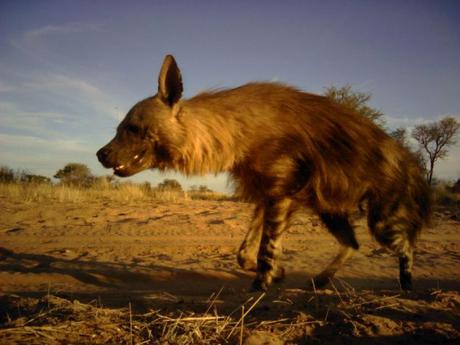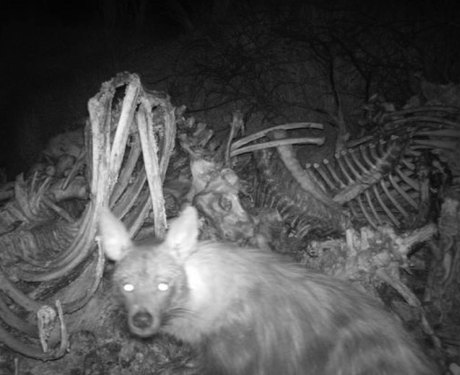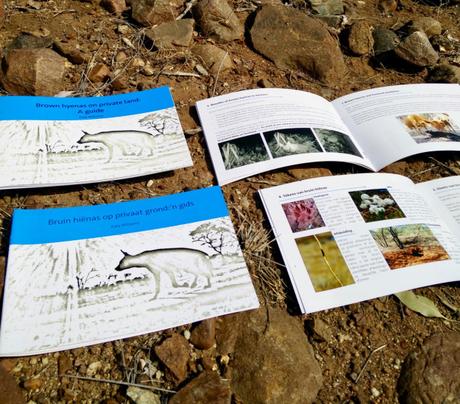By Katy Williams
A wide variety of species rely on land outside of protected areas for their survival. One example is the brown hyaena. Brown hyaenas are only found in southern Africa and a large proportion of the brown hyaena's range is on private land used for game or livestock farming (Kent and Hill, 2013; Winterbach et al., 2017). Despite the importance of these areas for brown hyaena success, living on private land often implies close proximity to humans, and this can be extremely risky. Brown hyaenas are persecuted for perceived or real livestock and game predation, and killed inadvertently through poisoning, in road collisions, and in wire snares (Mills and Hofer, 1998).

Figure 1. Brown hyaena. Photo credit Panthera.
Greater protection for brown hyaenas is required on private land, but this needs to be accompanied with better knowledge and understanding about brown hyaenas. Unfortunately, this secretive species is often misconstrued and undervalued. As predominantly scavengers, brown hyaenas pose little threat to livestock (Williams et al., 2018) and are extremely beneficial to farmers. They play an important ecological role in cleaning up dead animals naturally and reducing disease transmission (Beasley et al., 2015).

Figure 2. Brown hyaena cleaning up carcasses at a vulture restaurant. Photo credit Johan Botha
Thanks to financial assistance from the Primate and Predator Project (PPP), the Earthwatch Institute, an anonymous donor, and the National Research Foundation, I have produced a short booklet entitled 'Brown hyenas on private land: A guide'. The booklet provides information about the brown hyaena's diet, ranging, habits, and identifying signs, tips for living with brown hyaenas and other predators, and the benefits of having brown hyaenas on private land.
The booklet is available in English and in Afrikaans, both as PDFs and as hard copies. The PDF version can be accessed on the PPP downloads page ( click here). At present, we have only been able to fund the booklet in two languages. We would love to be able to print more copies in more languages in the future.

Figure 3. English and Afrikaans brown hyaena guidebooks.
The booklet will be distributed across the brown hyaena range through conservation organisations and government officials. We hope that this resource will help improve the way brown hyaenas are understood and promote conservation.
If you would like more information about this booklet, please feel free to contact me at [email protected].
References:
Beasley, J.C., Olson, Z.H. and DeVault, T.L. (2015) Ecological role of vertebrate scavengers, In Carrion Ecology, Evolution, and Their Applications. eds. Benbow, M.E., Tomberlin, J.K. and Tarone, A.M., pp. 107-121. CRC Press, Boca Raton.
Kent, V.T. and Hill, R.A. (2013) The importance of farmland for the conservation of brown hyaena, Parahyaena brunnea. Oryx 47, 431-440. doi:10.1017/S0030605312001007.
Mills, M.G.L. and Hofer, H. (1998) Hyaenas: Status Survey and Conservation Action Plan. IUCN/SSC Hyaena Specialist Group, Gland.
Williams, K.S., Williams, S.T., Fitzgerald, L.E., Sheppard, E.C. and Hill, R.A. (2018) Brown hyaena and leopard diets on private land in the Soutpansberg Mountains, South Africa. African Journal of Ecology, doi:10.1111/aje.12539.
Winterbach, C.W., Maude, G., Neo-Mahupeleng, G., Klein, R., Boast, L., Rich, L.N. and Somers, M.J. (2017) Conservation implications of brown hyaena ( Parahyaena brunnea) population densities and distribution across landscapes in Botswana. Koedoe 59, 1-16. doi:10.4102/koedoe.v59i2.1441.
